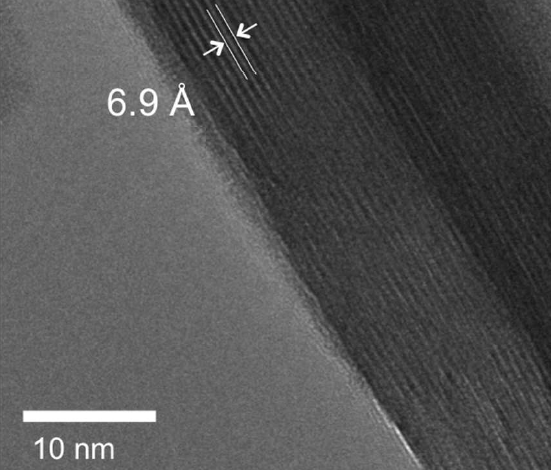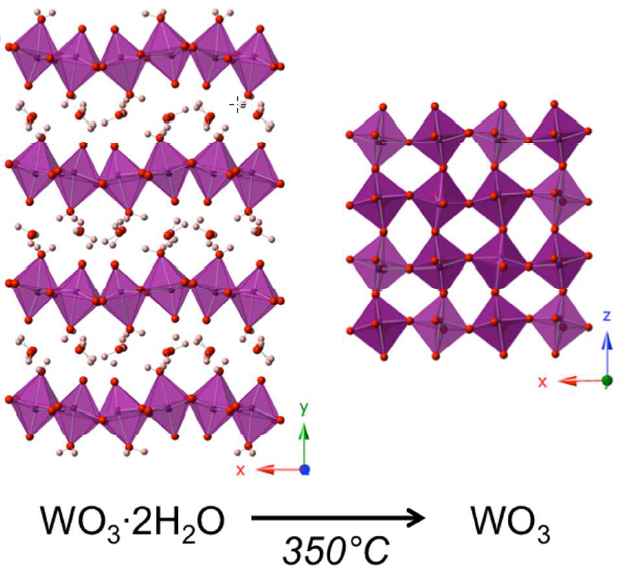An atomically thin layer of water stores more energy and delivers it faster, researchers discover
May 3, 2017

A high-resolution transmission electron microscope image of layered, crystalline tungsten oxide dihydrate, which acts as a better supercapacitor (similar to a battery) than plain tungsten oxide (without the water layer). The “stripes” are individual layers of atoms separated by atomically thin water layers; the gray area on the left is empty space. 6.9 Angstrom = 0.69 nanometer. (credit: James B. Mitchell et al./Chemistry of Materials)
Researchers at North Carolina State University have found that a material* that incorporates atomically thin layers of water can store more energy and deliver it much more quickly than the same material without the water.
The proof-of-concept finding could “ultimately lead to things like thinner batteries, faster storage for renewable-based power grids, or faster acceleration in electric vehicles,” according to Veronica Augustyn, an assistant professor of materials science and engineering at NC State and corresponding author of a paper in the journal Chemistry of Materials describing the work.
A basic goal of current energy-storage research is to combine the high energy-density (amount of energy stored) of batteries with the high power density (speed of charge/discharge) of capacitors. The new finding is a step in that direction — it could allow for an increased amount of energy to be stored per unit of volume, faster diffusion of ions through the material, and faster charge and discharge.

Crystallographic structures of tungsten oxide dihydrate (WO3.2H2O) and tungsten oxide (WO3). Dehydration of the layered hydrated phase (left) under heat treatment in air or in vacuum yields the anhydrous structure (right). (credit: James B. Mitchell et al./Chemistry of Materials)
In this research, the scientists compared two materials: a crystalline tungsten oxide and a layered, crystalline tungsten oxide dihydrate, which consists of crystalline tungsten oxide layers separated by atomically thin layers of water. When charging the two materials for 10 minutes, the researchers found that the regular tungsten oxide version stored more energy than the hydrate version. But when the charging period was only 12 seconds, the hydrate version surprisingly stored more energy than the regular material and stored energy more efficiently, wasting less energy as heat.
“Incorporating these solvent layers could be a new strategy for high-powered energy-storage devices that make use of layered materials,” Augustyn says. “We think the water layer acts as a pathway that facilitates the transfer of ions through the material. We are now moving forward with National Science Foundation-funded work on how to fine-tune this ‘interlayer,’ which will hopefully advance our understanding of these materials and get us closer to next-generation energy-storage devices.”
* The new material acts as a “pseudosupercapacitor” (between a battery and a supercapacitor, which is used in applications requiring many rapid charge/discharge cycles rather than long term compact energy storage, such as in cars, buses, and trains). The new material improves both energy density and power density.
Abstract of Transition from Battery to Pseudocapacitor Behavior via Structural Water in Tungsten Oxide
The kinetics of energy storage in transition metal oxides are usually limited by solid-state diffusion, and the strategy most often utilized to improve their rate capability is to reduce ion diffusion distances by utilizing nanostructured materials. Here, another strategy for improving the kinetics of layered transition metal oxides by the presence of structural water is proposed. To investigate this strategy, the electrochemical energy storage behavior of a model hydrated layered oxide, WO3·2H2O, is compared with that of anhydrous WO3 in an acidic electrolyte. It is found that the presence of structural water leads to a transition from battery-like behavior in the anhydrous WO3 to ideally pseudocapacitive behavior in WO3·2H2O. As a result, WO3·2H2O exhibits significantly improved capacity retention and energy efficiency for proton storage over WO3 at sweep rates as fast as 200 mV s–1, corresponding to charge/discharge times of just a few seconds. Importantly, the energy storage of WO3·2H2O at such rates is nearly 100% efficient, unlike in the case of anhydrous WO3. Pseudocapacitance in WO3·2H2O allows for high-mass loading electrodes (>3 mg cm–2) and high areal capacitances (>0.25 F cm–2 at 200 mV s–1) with simple slurry-cast electrodes. These results demonstrate a new approach for developing pseudocapacitance in layered transition metal oxides for high-power energy storage, as well as the importance of energy efficiency as a metric of performance of pseudocapacitive materials.